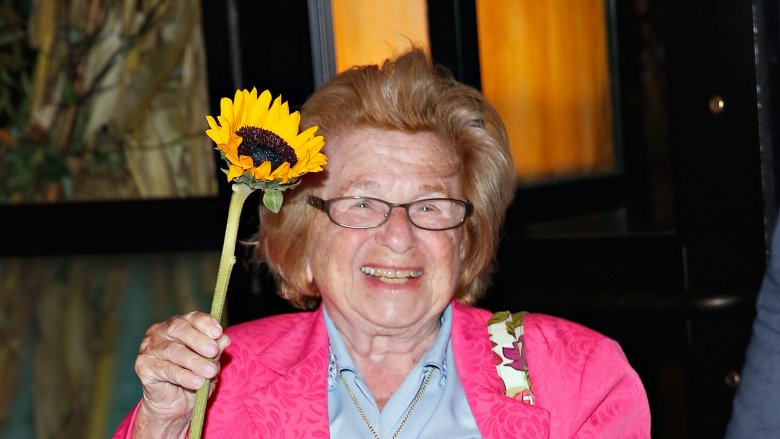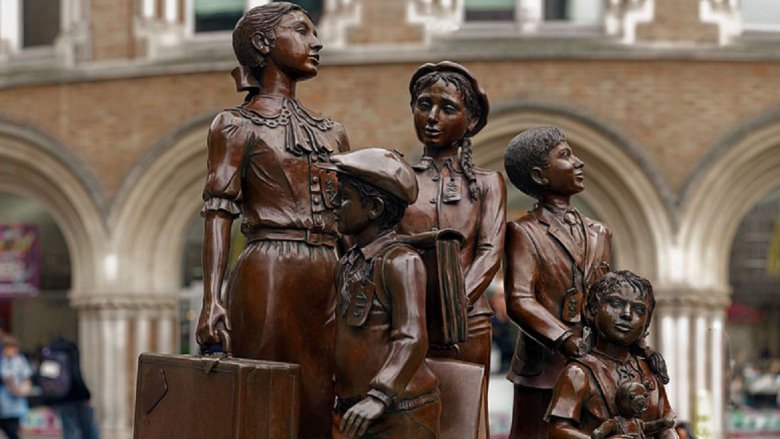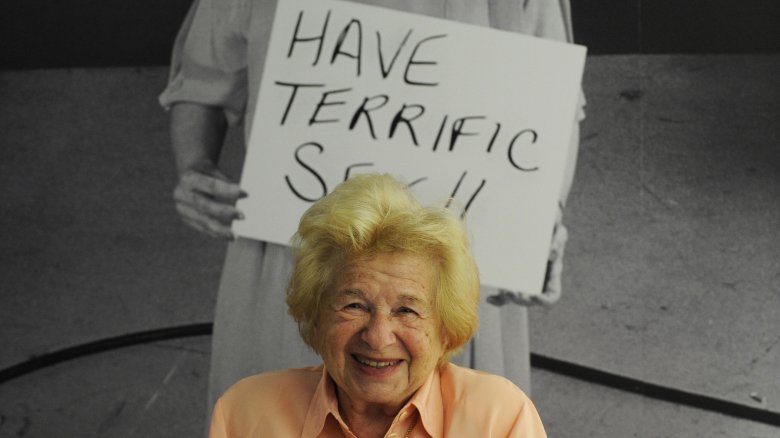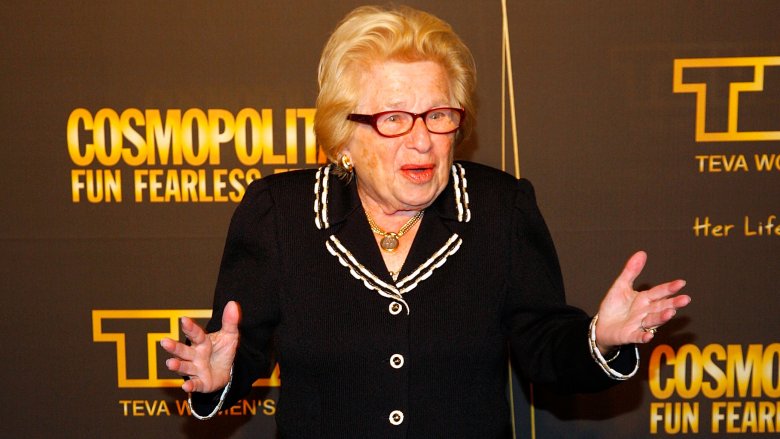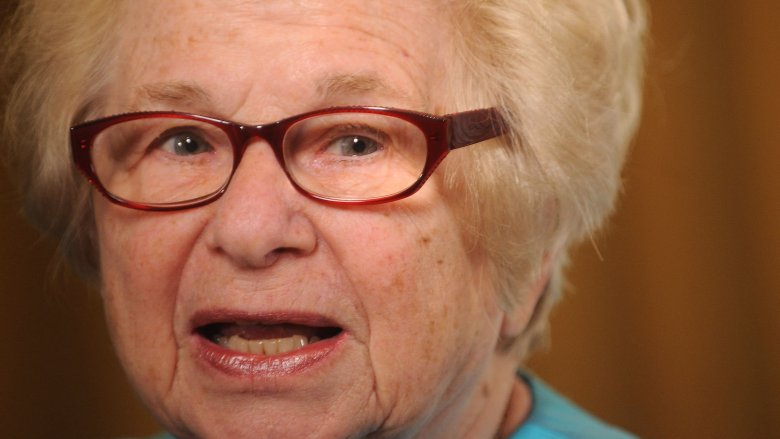The Untold Truth Of Dr. Ruth
Dr. Ruth Westheimer has spent decades teaching lovers how to better mush their meats together. Her frank discussions about ding-dongs and hoo-has have made the private lives of privates more publicly acceptable to talk about. Through her tireless efforts she has truly put the "lust" in illustriousness. But there's much more to her than helping people play doctor. Dr. Ruth's life has had more ups and downs than you can shake a condom at, and you're about to learn the ins and outs of them. So put on some mood music, turn the lights down low, and get ready to have your mind blown.
Escaping the Holocaust
As of this writing, Dr. Ruth is 89 years old and will likely outlive the Sun. However, had things gone differently in 1939, she might not have made it to her 18th birthday. Back then she was 10-year-old Karola Ruth Siegel, a German Jew fleeing annihilation. As Dr. Ruth described to The Guardian, a happy childhood in Frankfurt "with two loving parents and an adoring grandmother who spoiled" her had been completely upended by the Nazis.
In November 1938, Nazi thugs besieged Jewish-owned businesses and synagogues during the Night of Broken Glass. They also abducted Dr. Ruth's father. She recalled her "grandmother giving the Nazis money, saying, 'Take good care of my son.'" He later died at Auschwitz. In 1939 Dr. Ruth bid farewell to the rest of her family and departed for Switzerland as part of a child rescue initiative called the Kindertransport.
Dr. Ruth surmised that if she'd ended up in Holland, Belgium, or France, she would have been among the 1.5 million Jewish children who died in the Holocaust. Sadly, her family couldn't be spared. After two years of getting letters from her loved ones, all communication ceased. The loss left gaping psychological wounds. At 59 years old she told a therapist, per The New York Times, about ordinary objects that evoked thoughts of her parents dying. 'When I see a shower head or a fire sprinkler," Dr. Ruth explained, "I can't help thinking, 'This is how it happened.”'
Orphaned in Switzerland
At the tender age of 10, Dr. Ruth saw her life torn to tatters. She had lost everyone and everything and now had to adjust to a new life in Heiden, Switzerland. There she resided at a children's home that morphed into an orphanage over time. It was a refuge from persecution but not a reprieve from pain. Per The New York Times, Dr. Ruth clung to the hope that her parents would escape like she did. When that didn't happen, she blamed herself for not remaining in Germany to protect them.
Meanwhile, orphanage life proved onerous. According to the book The Things That Matter, Dr. Ruth was made a maid for other orphans. In her words: "At the Heiden home in Switzerland, the German Jewish children like me became the maids for the Swiss children. We cleaned their toilets, made their beds, scrubbed the floors, did all the laundry, helped them bathe." When she wasn't running errands, she was running afoul of authority figures. Dr. Ruth often got scolded for teaching the other kids about baby-making and menstruation. (She had learned about these things by sneakily reading her parents' marriage manual.)
Despite being full of information, Dr. Ruth was starved for knowledge. As she told The Washington Post, education was a right reserved for boys. However, she fed her intellectual hunger by borrowing school books from a boy she dated. In the process, she taught herself high school-level history and English.
Dr. Ruth the riflewoman
At age 17 Dr. Ruth relocated to Palestine, per The Washington Post. After losing her home, she wanted to help found a Jewish homeland. But she also found a hidden talent: shooting things.
In an interview with The New Yorker, Dr. Ruth discussed joining the Haganah, the Palestinian precursor to the Israeli Defense Forces. She wasn't particularly partial to guns, but she wanted to fit in somewhere. "In 1947 and '48, everybody in then-Palestine belonged to some group," she recalled. As it turned out, she had a natural facility for firearms. She had excellent aim and "could put the five bullets in the red circle." She was also pretty handy with hand grenades.
According to The Guardian, Dr. Ruth got a taste of combat during the war of Israeli independence. It's tempting to picture the 4-foot-7 therapist as a ferocious soldier giddily giving hell to combatants in her crosshairs. But life isn't an action movie, and the action Dr. Ruth saw was ugly. She recounted her harrowing experience to Philadelphia Magazine: "I got badly wounded by a shell exploding near me, killing the girl next to me and some others, but I never killed anyone as a sniper."
Injury instigated another huge shift for Dr. Ruth. Following her bitter bout with war, she moved to Paris and worked as a kindergarten teacher. She also took up psychology at the Sorbonne. Her circuitous evolution would soon have a clear trajectory.
Maid in America
You'd think that after surviving an explosion in Israel, Dr. Ruth would have a blast in Paris. But it wasn't all brioche and rainbows. Per Biography.com, her finances were practically imaginary. Sometimes her only meal for a day was a cup of coffee. At the time she was married, but love seemed lacking. According to People, Dr. Ruth had tied the knot with "the first guy who offered to marry" her, seemingly due to low self-esteem. They would divorce due to "lack of interest."
After parting with her partner, she planned to leave Louvre Land for the U.S. Unexpectedly, a mighty fine Frenchman came into her life. He even came with her to New York, where Dr. Ruth pursued a master's degree in sociology. She also had her first child, which led to her second marriage, but hardship wasn't done with Dr. Ruth.
The family scraped by financially. Dr. Ruth worked as a housemaid for $1 an hour while going to school at night. Her second marriage also collapsed, this time from intellectual incompatibility. Nonetheless, she trudged forward with the help of friends and fortitude. She juggled school, work, and motherhood, and still found time to date. While on a ski date with a new mate named Hans, she met her future third husband and the father of her second child, Fred Westheimer. It only took them nine months to say "I do," and they would stay married until Fred's death in 1997.
The road to doctor-dom
Dr. Ruth refused to remain a maid forever. According to Biography.com, in the late 1960s she got a job working for Planned Parenthood, where people often discussed jiggly-wrigglies and love hugs. She found the conversations off-putting, but not for long. She told Hadassah Magazine: "I listened to them talking and I thought, 'These people are crazy! They don't talk about anything but sex.' Forty-eight hours later I said, 'Very interesting. They don't talk about anything but sex!'"
It dawned on Dr. Ruth that sex wasn't something to hide but to hone and comprehend. So she set out to become a sex educator. As the book Becoming Dr. Ruth detailed, the aspiring sexpert feared failure at first. But after acing a class at Columbia Teachers College, there was no going back. She immersed herself in sex and emerged with a doctorate in education in 1970. Then, she met Dr. Helen Singer Kaplan.
According to Dr. Ruth, Kaplan had co-written "the bible for sex therapists." After watching her speak, Dr. Ruth became her disciple. For seven years she took Kaplan's classes and watched her sex therapy sessions. She heard things that made her blush and gave her a rush. She had found her calling. A psychiatrist would later point out that Dr. Ruth's choice of careers may have also been a response to her intimacy-deprived upbringing. After leaving Germany, she went years without physical affection. Perhaps by helping others she was helping herself.
Dr. Ruth's first horizontal hug
For a person famous for sex talk, Dr. Ruth can be pretty tight-lipped about her own humping habits. For instance, in 2015 a Washington Post reporter posed the question: "People must ask about your sex life. What do you tell them?" Her reply: "Next question!" When discussing sex and aging with that same outlet in 2013, she declined to directly address her own geriatric bone-jumping (or lack thereof) and instead told jokey anecdotes.
Perhaps the issue is Dr. Ruth's professedly "old-fashioned" personal views on sex. Or maybe her wrinkly thrust-athons are just too hot for the world to handle. Either way, her avoidance seems to speak volumes. It suggests that despite wanting others to divulge intimate information, she often remains guarded. Perhaps her tragic past and romantic struggles made one-way openness easier. However, Dr. Ruth hasn't been completely mum about her carnal adventures. On multiple occasions the therapist has discussed how she lost her virginity.
In Dr. Ruth Shares All, the therapist revealed that it happened in a hayloft in Palestine. She described her coital encounter as "wonderful," adding: "We visited that hayloft again and again (and that I didn't wind up pregnant was a minor miracle, because we weren't using any form of birth control)." Per The New York Times, Dr. Ruth's only hay-roll regret was that lack of contraception. Even so, she saw the bright side, remarking, "I know much better now and so does everyone who listens to my radio program.”
Dr. Ruth's pop-up sex book for kids
Dr. Ruth doesn't just talk the sex talk; she also writes it. Per her official website, she's authored over 30 books, such as the sultry-sounding Dr. Ruth's Guide to Sensuous and Erotic Pleasures and the infinitely unsexy Dr. Ruth's Guide to Talking about Herpes. She also has works aimed at children, including a pop-up sex book because no one's too young for innuendo.
The innocuously titled Who Am I? Where Did I Come From? is Dr. Ruth's attempt to teach kids about birds, bees, beaks, and stingers. Given the book's 3-D format, it's hard not to envision bulging paper dude bits on every page. But Dr. Ruth assured The Chicago Tribune that the work contained no R-rated representations. Specifically, she stated: "No member of the male sexual body pops up." However, it is worth noting that she insisted on having "a lift-the-flap page that reveals the difference between girls and boys."
Additionally, the book touches on love-making and delves into the nitty-gritty of conception. To some, that might seem way too heavy for a kid's brain to handle. But Dr. Ruth proudly contrasted her creation with lighter works: "There's a children's book out that says, 'Vagina rhymes with North Carolina' — that's not my way of teaching. What does the state of Carolina have to do with vagina?" That might be funny for us, but that is not the way I would like children to think about sex and the way they are born."
The doctor's accidentally bad advice
It can take of thousands of words to write a book, but you only need one to ruin it. Remember when The Pasta Bible listed "freshly ground black people" as a meal ingredient? That was a fun disaster, wasn't it? Thankfully, Dr. Ruth never mistakenly instructed people to commit race-based cannibalism in the bedroom. Instead, she gave young people terrible sex advice.
In 1986 The Washington Post reported on a glaring error in the book First Love: A Young People's Guide to Sexual Information. Chapter 10 of the text contains a line meant to caution (heterosexual) teens against doing the naked mambo near a female's ovulation period. Failure to heed that tip could result in babies. The relevant sentence should have said: "The unsafe times are the week before and the week of ovulation." But it actually called those times "safe," making the advice unsafe to follow.
A librarian in New Jersey spotted the snafu and promptly brought it to Dr. Ruth's attention. The author was mortified and purportedly lost sleep over the oversight. Her editor allegedly wept. A wallet-walloping 115,000 copies of the book had to be recalled. Much to Dr. Ruth's relief, the guide hadn't been a huge hit. Otherwise her finances might have taken a hit due to infant-related lawsuits.
Dr. Ruth's controversial stance on rape
Over the course of her life, Dr. Ruth has been many things: a survivor, a sniper, a housemaid, a hay-maiden, a student, a scholar, a wife, a mother, a show host, and a show guest. Plus, there's all that sex stuff. But above all, she's a person, and sometimes people upset you. Sometimes they buy the last frozen burrito at the grocery store. Sometimes they accidentally tell teenagers to make babies. And occasionally, they say unsettling things about rape.
In 2015, The Palm Beach Post reported on controversial comments Dr. Ruth made while appearing on The Diane Rehm Show. Specifically, she dismissed the notion of a woman being able to refuse sex once she's naked in bed with a man. As she put it, "Most of the time, they think she can say, 'I changed my mind.' No such thing is possible."
She didn't misspeak. In fact, she's held that same view for decades. According to The Harvard Crimson, during a 1991 visit to Harvard, the Dr. Ruth asserted, "If you don't want to have sex, you have no business being naked in bed with someone." She further warned that "a woman can't tease." That's disconcerting to say the least. But as The Daily Beast observed, her stance is rooted in her interpretation of Judaism: "In the Jewish tradition, it says that if that part of the male anatomy is aroused, the brain flies out of the head." Obviously, biology isn't Dr. Ruth's forte.
The dollhouse collector
For nearly 80 years, Dr. Ruth has been 10 years old. Not biologically, obviously, but in spirit. Marred by childhood trauma, she copes by collecting dollhouses. In an article for AARP she wrote: "I have six. Two are almost as tall as I am — I'm 4 feet 7. I collect them because I have control over them, which I did not have in my life."
Dollhouses also have a deeper symbolism, one tied directly to untroubled parts of her youth. While speaking with The Washington Post's Ellen McCarthy, she recalled owning 13 dolls in addition to roller skates and baby carriages. When she left for Switzerland, Dr. Ruth only had one doll, which she gave to a crying child who "needed it more." It was one of the last shreds of her old life she had left.
In adulthood, Dr. Ruth bought dollhouses during her travels. She adorned them with little doll families and toys she never got to enjoy herself. Even the tables and chairs had special meaning. In her AARP article, Dr. Ruth wrote: "Most of the furniture comes from England and is of the period between the two World Wars, when I was a child." For her these objects serve as more than toys: they're surrogate snapshots of moments that never were. They've also been her playmates in times of sadness. That's heartbreaking but also heartening in a way. No matter how much she lost, she still found a way to smile.
